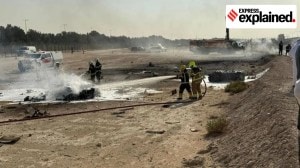Sonar detectors to aid search for black box
Black box of the Boeing 737-800 aircraft that crashed at Mangalore remains untraceable.
The digital flight data recorder (DFDR),or the black box,of the Boeing 737-800 aircraft that crashed at Mangalore remained untraceable for the third day,despite extensive searches carried out under the supervision of investigating officials from the office of the Director General of Civil Aviation (DGCA). This has forced a re-think on strategies to recover the vital device including a possible inquiry through police officials at the local villages from where people gathered to help in the rescue operations.
DGCA officials on Monday said they would be introducing two sonar detectors being flown in from Mumbai with Indian Airlines technicians for the first time on Tuesday to pick up signals emitted from the black box. Though typically used in deep water searches for the DFDR,we are going to use this equipment here since the DFDR has not been found, a DGCA official said.
Crash site emergency professionals from the international agency,Kenyon,got a feel of the site on Monday and are expected to assist on bigger scale in the search operations on Tuesday,an Air India official said. The three days of search have so far yielded the cockpit voice recorder and a flight sensor,but not the DFDR.
The search for the DFDR located in the rear upper portion of the galley region of the aircraft has been painstakingly difficult since the portion of the aircraft where it is located is missing from the debris among the shrub and trees where the plane crashed,avionics engineers involved with the search said. A part of the galley region has been recovered,but the portion that specifically houses the DFDR is missing, an investigator at the crash site said.
Avionics engineers have been a part of the investigation team,headed by senior DGCA official Arun Kumar Chopra,on account of their ability to identify the DFDR or portions of it if it were to be found by the team of over 30 search personnel deployed from the DGCA,Air India Express,the local fire force and casual laborers. On Tuesday much of the search was supervised by the Director General of Civil Aviation Nasim Zaidi.
The DFDR is considered crucial to understanding the final moments of the aircraft and to pinpoint the cause of the crash since it records data for 124 different parameters. The black box is the ultimate proof of what happened to cause the crash, an engineer said. Workers set out on Monday for the search after being shown diagrams of two different types of DFDRs.
Under normal circumstances the black box is in a particular location but in this case it could have been thrown a great distance in front of the aircraft due to the impact of the crash. It could have been cut away during rescue operations as well. We are considering extending the search area by 50 meters into the valley, a senior DGCA official said. Though built to be fireproof,the DFDR can suffer external damages,officials said.
DGCA officials have also been speculating on whether the device could have been taken away by any of the hundreds of local villagers who were a part of the rescue operations in the immediate aftermath of the crash or whether the DFDR could have been moved out from the crash site after being mistaken for something else. A DGCA investigator spoke to local fire force and police personnel on Monday and asked if they could go around with pictures of the black box asking people in the villages whether anybody had sighted the device around the crash site.
Boeing asks DGCA to preserve aircraft debris for three years
US aircraft manufacturer Boeing,whose 737-800 aircraft was involved in the Air India Express IX 812 crash in Mangalore,has asked the DGCA to preserve the remains of the aircraft for at least three years in order to study the cause and effect of the crash. A two-member team of US engineers from the company visited the crash site on Monday.
DGCA officials have informed Boeing personnel that access could be provided only after DGCA itself completes its investigations into the crash and its cause,including its examination of the black box of Boeing 737-800 as and when it is found.
DGCA officials are said to have told the US engineers on Monday that Boeing would have to shoulder the costs of analyses and the preservation of the debris of the Mangalore site since such procedures are non-existent in India. The Boeing engineers have said the costs would be covered through the insurance of the aircraft.
In the US and other countries,crash debris are salvaged and preserved for studies and not scrapped,officials said.
Of particular interest in the 737-800 crash,apart from DGCAs studies of how flight control was lost,is how the plane exploded,how its body split after falling down the valley below the Bajpe airports 06/24 runway and how different parts of the aircraft were destroyed.
The Boeing aircraft involved in the Mangalore crash,registered as VT-AXV,was 737-8HG,a part of Boeings next generation series of 737 aircraft.



- 01
- 02
- 03
- 04
- 05




























